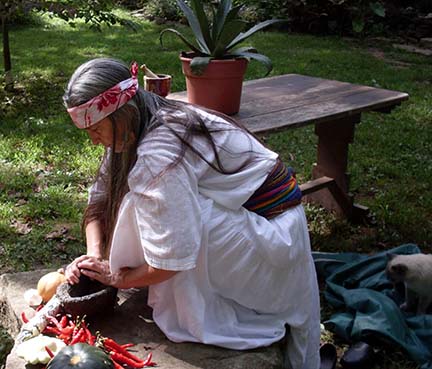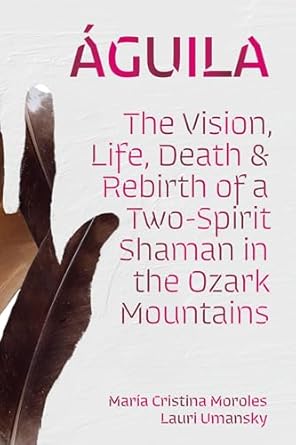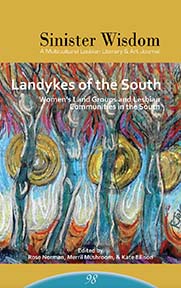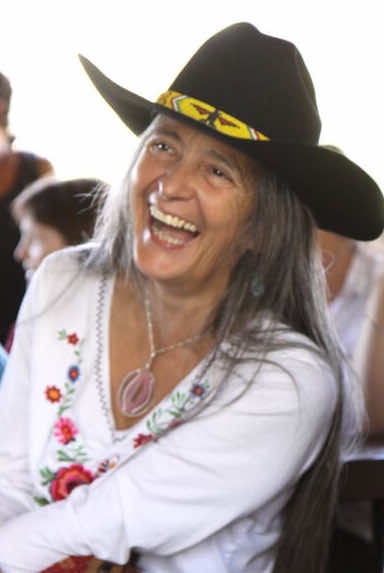Águila: The Vision, Life, Death and Rebirth of a Two-Spirit Shaman in the Ozark Mountains

Reviewed by Rose Norman
- Águila Talks about Her Memoir
- Maria Cristina Moroles (Águila): Building Sacred Community on the Land
“Always remember that you are proud. You are proud first because you are an Indian; second, because you are a Mexican; and last, because you are an American.” With these words, Maria Cristina Moroles’s father, José Moroles, sent her off to first grade in Dallas, Texas. Having crossed the border undocumented twenty-seven times, her father knew hardship. But he did not anticipate just how hard those Dallas schools would be on his oldest daughter, who quickly learned how to fight and not back down.

Águila is the story of how that little girl survived poverty, a rapist’s pregnancy, subsequent foster care, life on the streets, and a deadly hepatitis epidemic. Despite all of that, she founded the rugged Ozark mountain sanctuary for women and children where she has lived since 1976. Arco Iris, Rainbow Land, now Santuario Arco Iris, is one of many women’s land communities. It is remarkably rare in being founded by women of color. Both the land and the sanctuary it became are the vision in the title of this memoir.
Maria Cristina’s story is complicated and unpredictable. She grew up in a strong, nurturing family until she was raped and impregnated at age twelve. Everything changed for her after that because she lost the respect of her parents and siblings. In the hospital giving birth, she found the same racism and bullying she faced in school, and the baby was injured by rough handling in delivery. Relatives adopted that baby; and Maria Cristina left her family to live on the streets, where she began to have a recurring dream about a mountain. At fifteen, in 1968, she married a street boy as a way of escaping the foster care system that they both kept being forced into as juveniles. Together, they began to put together a life. They had a daughter, Jennifer, in 1971.
The following year, 1972, when she was nineteen, Maria Cristina hitchhiked to Austin, Texas, where she met a couple who told her about a beautiful mountain in Arkansas where they were planning to move. They encouraged her to move there, too, and she began saving money for the move. The next year, 1973, she moved to Fayetteville, Arkansas, with her husband and daughter, and her life changed again. Soon after moving to Fayetteville, she divorced her husband, took a woman lover, and found Sassafras, which was at that time a women’s land collective on a beautiful mountain. She had hoped that would be the mountain of her dream. Instead, she found a hippie drug culture that did not appeal to her.
When the hepatitis epidemic brought her to death’s door, Maria Cristina was taken by her lover to Sassafras for healing. That is where she “died” and was reborn. The Sassafras women were drumming outside the pottery shed where she was dying when she had another vision. An Indian woman came to her and told her, “You are not going to die. You are resting, and you will be going back. You will start anew. Your new life will begin. You have a path that you will walk… You are reborn to this Rainbow Land, Arco Iris.” The vision went on for days, ending with a hawk emerging out of the sun screeching. That is when she got her first medicine name, SunHawk, and when she began her formal journey as a curandera, a traditional healer.

Maria Cristina told part of this story in the short memoir published in the SLFA Herstory Project’s Landykes of the South, volume 98 of Sinister Wisdom (2015). In Águila she tells it in much greater detail, together with the complicated series of events that followed her death and rebirth, and her return to the Ozarks to live on the mountain next to Sassafras. The 120 acres of mountain land that became Santuario Arco Iris was and is very, very rugged. When she moved there with her five-year-old daughter, the road was undriveable, and there were no structures on the land. Her memoir tells the story of how she turned that land into a sanctuary for women and children.
It also traces her journey as a curandera and shaman who in recent years was elevated to the status signified by the name Águila (AH-ghee-la), eagle, her shaman name and highest rank as a shamanic healer. This name is, she writes, “both a gift and a burden,” as it is a high responsibility. Writing of the ceremony in which her teacher bestowed on her the eagle feather penacho (headdress), she said, “The eagle feathers poured pure energy into me, suffusing my whole being with an electric peace, with all of the energies of the Universe melded into one force, intensely beautiful, transitory, seen from the eye of an eagle in flight. I felt all fear drain away. I began to walk, encircled by a calm illumination, to the roundhouse. Dear ones waited there, and Spirit led the way. I walked in beauty.”

Águila’s journey is amazing. A few years after moving to the mountain of her vision, the collective that owned Sassafras deeded her the land that became Santuario Arco Iris. Much later, the collective deeded her the 450 acres that had been Sassafras, and with Águila’s efforts, it became what is now the nonprofit Arco Iris Earth Care Project. The website for the nonprofit states their mission: “to protect Our Sacred Mother Earth by conserving Ozark wilderness land, teaching environmental education; preserving indigenous and Ozark cultures; and providing a sanctuary that empowers women and children of color, displaced indigenous peoples, and our community with natural and healthy skills for sustainable living and self-sufficiency.”
In a story full of amazing events, perhaps the most amazing thing about this story is that this memoir got written at all, and how it got written. Águila’s coauthor, Dr. Lauri Umansky, a historian and former dean at Arkansas State University, first came to Santuario Arco Iris when she was working on a much larger project about activist Arkansas women, a project later abandoned. Santuario Arco Iris, in northwest Arkansas, is five hours from Umansky’s home in northeast Arkansas. On that first weekend visit, Umansky and Águila connected on a deep, personal level. They had some shared experiences that resonated. “We have a lot of common experience in women’s community,” Umansky said in an interview, “in feminist community, counter-culturalism, and some things in common in our personalities, as risk-taking people who are not hewing to convention.”

Lauri Umansky quickly realized that Águila’s story was far more than a chapter in the book that Umansky then envisioned. She also knew, intuitively, that Águila would be “a good writing partner for her in the story.” Assuredly, the two have major differences, notably that Umansky is an Ivy League-trained scholar (PhD, Brown University) who doesn’t speak what she termed “the language of spirituality” that is central to Águila’s being. She did not feel about the book the way that Águila did, who said, “Creator is telling me, Creation is telling me to do this.” Yet Umansky did feel sufficiently drawn to the story that she “didn’t approach the project as a scholar. I let that go. For me, it was more like a promise to a dear friend.”
Except for the Afterword, written in Lauri Umansky’s voice, the book is told entirely in Águila’s voice, based on over fifty hours of recorded interviews that Umansky transcribed. It took years of back and forth; reviewing and editing; shaping and reshaping to put together the memoir we now have. The book is a remarkable achievement, an artfully crafted story combining narrative, poetry, and prayers. It includes a photo essay about the death and green burial of an old friend, Isis Sheila Brown, who came to Arco Iris hoping to be healed, and ultimately, to die.
Above all, it is a story of resilience and healing on women’s land. We have few books about women’s land communities, and even fewer about women’s land started by women of color. This is an important one.
Águila: The Vision, Life, Death & Rebirth of a Two-Spirit Shaman in the Ozark Mountains. By Maria Cristina Moroles and Lauri Umansky. University of Arkansas Press, 2024. 174 pages. $34.95
An earlier version of this review appeared in Wild Shrew Literary Review.
See also:
Águila, “Arco Iris, Rainbow Land: The Vision of Maria Christina Moroles,” Sinister Wisdom 98 (2015): 46-52.
Águila Talks about Her Memoir, (interviewed by Rose Norman, April 2, 2024)
Maria Cristina Moroles (Águila): Building Sacred Community on the Land (interviewed by Rose Norman, October 27, 2014)
Merril Mushroom, “Arkansas Land and the Legacy of Sassafras,” Sinister Wisdom 98 (2015): 36-45.
